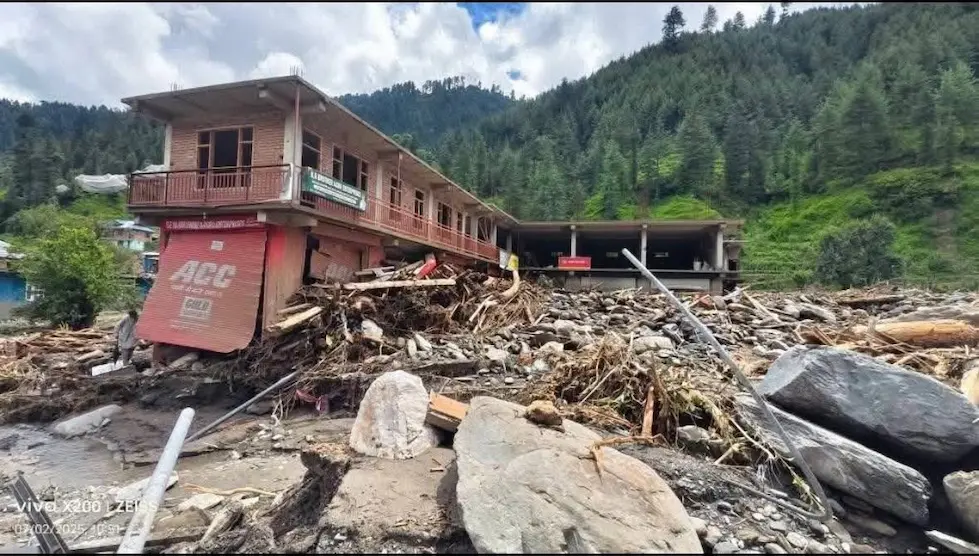
A massive landslide buries a key mountain road in India, leaving communities stranded and infrastructure crippled (source-X@GoHimachal)
1. Nature’s Fury Unleashed: A Road Buried, A Region Paralyzed
Landslide Havoc in Indian Hills – It began with rumblings beneath the fog-laced ridges of Himachal Pradesh- a slow, sinister shift beneath the earth that culminated in the collapse of an entire stretch of mountain highway. Within seconds, tonnes of mud, boulders, and uprooted trees surged down the slope, swallowing the arterial road and leaving vehicles, livelihoods, and rescue officials stranded amid the wreckage.
The scene was devastating: bus shelters buried in sludge, families displaced overnight, and stunned onlookers staring at the ground where a road once threaded through the hillside. The landslide didn’t just erase infrastructure, it erased confidence in the region’s safety.
This wasn’t an isolated incident. Across Uttarakhand, Sikkim, Arunachal Pradesh, and parts of Jammu & Kashmir, similar disasters have plagued hilly communities over the last decade. Torrential rains, reckless development, and ecological mismanagement have turned serene highlands into hazard zones. According to data from the Geological Survey of India, over 15% of India’s landmass is vulnerable to landslides, with the Himalayan belt accounting for the bulk of fatalities and infrastructural losses annually.
2. Fragile Hills, Flawed Development: A Recipe for Collapse
The post-disaster analysis inevitably points to one glaring truth: we built without foresight. As tourism boomed and connectivity demands surged, roads were carved hastily into steep inclines, often with minimal geological studies or slope stabilization measures. Entire mountains were drilled to lay highways, resorts, and tunnels, altering water flow, loosening rock beds, and disturbing the native flora that once held the soil firm.
Construction materials like concrete replaced natural retaining walls. Vertical cuts replaced gradual slopes. Tree covers were razed for view decks and helicopter pads. In many cases, even the mandatory environmental impact assessments were either bypassed or reduced to paperwork formalities.
In 2023 alone, over 60 major landslides were recorded in Himachal and Uttarakhand. While climate change remains a global contributor-bringing erratic monsoon bursts and cloudbursts; the damage is compounded by human agency. Unregulated stone mining, roadside dumping, and deforestation magnify the fragility of mountain ecosystems.
Even post-disaster reconstruction often lacks innovation. Roads are rebuilt with similar designs, drainage systems remain clogged, and no buffer zones are introduced. We fix what broke without asking why it broke in the first place.
3. Lives in Limbo: Displacement, Trauma, and a Call for Accountability
Beyond images of buckled asphalt and crushed vehicles lies a deeper tragedy. For locals living in hill districts, a road isn’t just connectivity; it’s access to schools, hospitals, markets, and disaster response. When landslides occur, entire communities are cut off, often for days.
Consider the recent incident in Manali, where two villages remained inaccessible for nearly a week. Medical emergencies had to be airlifted. Food supplies were rationed. Children missed exams, and a family mourning a death couldn’t transport the body to their ancestral cremation site.
The psychological toll is often overlooked. Constant fear of road collapse, house cracks, and evacuation alerts leaves residents anxious, especially children and elderly citizens. Many families are forced to migrate to cities, abandoning generational farmland and community heritage due to repeated natural trauma.
And yet, accountability remains blurred. Officials offer compensation. Contractors blame “natural forces.” Tourism boards focus on recovery advertising. But very few answer the pressing questions: Why wasn’t the road slope reinforced? Why weren’t early warning sensors installed? Why are illegal constructions still rising along unstable ridges?
When infrastructure becomes a gamble with human lives, governance must shift from reactive to preventative.
4. Path Forward: Learning From the Earth, Building With Respect
It’s time India rethinks its relationship with the mountains—not just as tourist destinations or resource hubs, but as living ecosystems with rights and limits.
First, geo-sensitive zoning must become mandatory. Towns and villages should be audited for slope stability before any new construction is permitted. Government bodies like the NDMA and ISRO should collaborate on real-time landslide forecasting, using satellite-based terrain analysis and AI-driven rainfall modeling to alert communities early.
Second, eco-engineering techniques must replace brute-force construction. Retaining walls built from locally-sourced bamboo, jute geotextiles, and vegetation reinforcement are cost-effective and sustainable. Natural drainage systems, terraced slopes, and bio-fencing can restore the soil’s capacity to hold during monsoons.
Third, community-based disaster planning is essential. Villagers should be trained in emergency response, first aid, and evacuation protocols. School curricula in hill regions must include environmental risk literacy. Citizen watchdog groups can monitor illegal encroachments and report lapses in slope management. Lastly, let us not forget policy willpower. Budget allocations must reflect risk maps. Accountability mechanisms must go beyond post-disaster relief and delve into structural reform. The mountains are speaking, through cracks, collapses, and cries. Listening now isn’t optional. It’s survival.
Stay updated with the latest news on Rapido Updates. Keep yourself updated with The World, India News, Entertainment, Market, Automobile, Gadgets, Sports, and many more
1 thought on “Landslide Havoc in Indian Hills: A Mountain Road Vanishes, Lives Disrupted; When Will We Learn?”
Comments are closed.